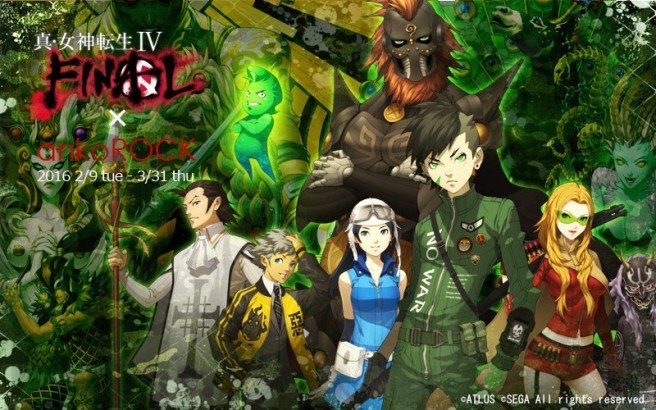Shin Megami Tensei IV Final devs – elements that define the series, considered older cast, music, more
Posted on February 20, 2016 by Brian(@NE_Brian) in 3DS, News
With Shin Megami Tensei IV Final having wrapped up and shipped in Japan, Famitsu spoke with some developers behind the game for a post-release interview. Character designer Masayuki Doi, producer Kazuyuki Yamai, and sound composer Ryota Kozuka talked with the magazine.
Famitsu has plenty of talk about the franchise in general as well as Shin Megami Tensei IV Final itself. The team spoke about what elements define the series, characters, music and more.
Head past the break for our full translation.
Famitsu: How did each of you first meet with the Megaten (Megami Tensei) series?
Yamai: The first time I played Megami Tensei on NES was during my junior high school years. I liked occult things that were booming in 1970s like town legends, mythology, etc., and Megaten happened to have all those. I also strongly feel this game is different from others because it had music with guitar rock despite being in the NES era.
Doi: I too played Megami Tensei first. I love the setting where gods and demons suddenly appear in an ordinary world. The demon fusion and partner system were also fresh. After the series became Shin Megami Tensei, I became intrigued further, and started reading lots of books about demons.
Kozuka: I first knew of Shin Megami Tensei on SNES, but at that time I was still a grade schooler, so I thought I was still too young to touch that (laughs). At that time I was playing mainly common fantasy-themed games, but when I played Devil Summoner among them, its contents impacted me, and after that I also played Soul Hackers. That’s when I got addicted to Atlus games.
Famitsu: Did everyone join Atlus because of that?
Doi: I joined to fill in creator vacancies. Back then I never thought I’d get to draw Megaten’s characters and demons in the future.
Kozuka: I also applied to Atlus because of Soul Hackers. I was moved when I got to work as sound director for the 3DS version.
Yamai: You both had a good chance meeting (laughs). I always liked Atlus games, but the motive behind joining Atlus was because I saw in a game magazine that the creators in Atlus were all posing with sunglasses, like it had a punk spirit unlike ordinary companies. Both the company and its games are ‘different from others’ and it suits me. Perhaps it’s because of that we got attracted to Atlus.
Famitsu: Mr. Doi has drawn this week Famitsu’s cover. I think it’s the first time a Shin Megami Tensei IV Final illustration is drawn with this atmosphere, isn’t it?
Doi: Yes. On the game’s main visual and the illustration for Famitsu’s first info batch (Oct. 22 2015), adhering to SMT4F’s theme of “bonds or massacre”, so we put emphasis on the atmosphere of the main character not being an ordinary human. A peaceful atmosphere, the opposite of the former, is the first time with this magazine cover. We want people to also know that there’s another side from the images that have been shown before.
Famitsu: Based on the “bonds or massacre” theme, while SMT4F takes the same setting from SMT4, I think it also draws a new line on the upcoming story development.
Yamai: The Megaten series has been always about choosing between going together with everyone or destroying everything, along with the conflicts and immoralities that accompany it, but those essences are being enhanced in SMT4F. In addition, to the opposite of SMT4 which was about drama of elites called Samurais which strayed away from their original path, SMT4F’s main characters are all newbies with some sort of inexperience. The main characters have their average ages lowered, and come from all sorts of positions. How will they grow from conflicts and dangers that they face, or will it become the trigger to player’s immorality… please check out the game for yourselves.
Kozuka: With such polarizing developments, not few of Megaten veterans might choose to go ‘the dangerous way’, but the way of massacre in SMT4F is really dangerous. The main characters in this game are still young and growing, so as the story goes [the player] might feel an affection towards them, so for those who usually go ‘the dangerous way’ might hesitate this time…
Yamai: That may be right. This game also has multiple story branches and endings, so there’s no single route that is the canon, so I’d like everyone to make their own choices. I especially would like people to go through the way they would’ve never chosen in the real world. Multiple playthroughs are also one of Megaten’s enjoyment points, and they’re also added in SMT4F, and the gaps between story developments will become noticeable.
Famitsu: What do each of you think really defines Megaten?
Yamai: I’d call it ‘Sharp Life Simulator’. Because for example when faced against such a conflict, the game asks the player ‘What would you do?’ and gives choices for the player to take. There’s also an immoral selection that doesn’t normally show up in other games, so it’s an RPG that can unleash the player’s hidden greed.
Doi: For me it’s freely playing inside the several [provided] paths. The world has contrasting realities like ‘good’, ‘evil’ and ‘neutral’, but it’s up to the player how they will set the world’s fate, and they can also raise demons as they want.
Kozuka: I think it’s where we deliberately conceal features that would be easy to understand. Like making this a very occultish world, but when speaking to demons they have funky dialects. But things like having pungent events where players least expect it would also make it more interesting so I think it can also be a characteristic.

